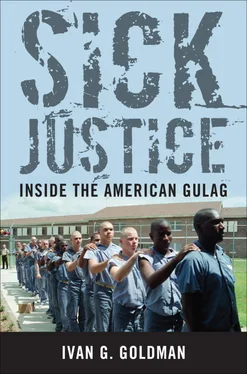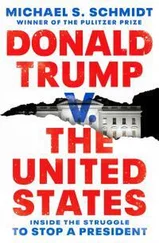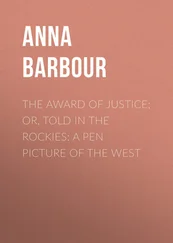2
Fear, Loathing, and Guns
SOCIETIES MORE CONCERNED WITH PUNISHMENT THAN WITH TRUTH CAN appear orderly, but only because the results of their priorities won’t be immediately visible. Citizens will know that a potentially disagreeable multitude is safely walled off somewhere, and they won’t need to know much more. But that kind of thinking got us where we are, with one in thirty-one U.S. adults in jail, prison, or on parole, according to a 2009 report from the respected Pew Center on the States. 1The U.S. Bureau of Justice Statistics counted 7,225,800 of these closely monitored or locked-up souls. 2
When the Supreme Court in 2011 upheld a lower court’s order to release thirty thousand prisoners from California’s terribly overcrowded penitentiaries, Justice Antonin Scalia issued a dissent that seethed with fear and loathing. Many of the released prisoners, he decided, “will undoubtedly be fine physical specimens who have developed intimidating muscles pumping iron in the prison gym.” 3The plaintiffs in the case had proved that an average of one convict per week was dying because of the awful state of medical care in the state prison system, but if Scalia saw this as a problem, he didn’t say so.
In some ways, Scalia’s legal opinion echoed the warning from South Carolina’s Keziah Goodwyn Hopkins Brevard, an antebellum slaveholder who feared that freed slaves might wreak revenge on their masters. Brevard was willing to liberate the slaves as long as it was to some foreign shore. When she learned of Lincoln’s election in November 1860, she wrote in her diary, “God be with us is my prayer and let us all be willing to die rather than free our slaves in their present uncivilized state.” She believed that once you wronged someone terribly, if you had that person cornered and under control, the best course of action was to maintain the status quo. 4
In 2009 Scalia was part of the 5-4 majority that denied inmates the right to postconviction DNA analyses, a remarkable decision that made it far more difficult to sort unjustly convicted inmates out of the prison population.
California’s law-and-order governor Jerry Brown, a staunch ally of the prison guards union, reacted to the federal mandate to cut down the number of state prisoners by announcing he would disperse the “released” convicts to county jails around the state, where in most cases conditions would be worse and opportunities for rehabilitation even more circumscribed. There would be no attempt to select the least dangerous among them and place them back in the community. Casey Mullenaux, for example, at age twenty-four was sentenced in Torrance, California, to three years for possessing ten dollars’ worth of black tar heroin. Mullenaux couldn’t qualify for help from the Innocence Project because he was guilty as charged. He also had a residential burglary on his record, a “strike” in legal parlance, which made him ineligible for drug counseling, probation, “or actually any alternative to prison,” as he pointed out to me in a stark letter from his penitentiary cell. Mullenaux is an obviously intelligent, eminently savable person, but at the age of twenty-four, with no violent crimes on his record, his country had already written him off as a total loss. He wrote, “Since I’ve been here already, it’s almost certain that I’ll get back here again. And I have.” 5
When low-level offenders like Mullenaux are paroled out of prison, local police monitor their movements. As parolees, they can be stopped and frisked for no reason. Constricted by special rules that strip them of basic rights, they’re far more likely to be arrested than the general population. Police tend to assume drug felons like Mullenaux are either behind bars or will be again soon, so getting them jailed again as quickly as possible after they return home may prevent the commission of new offenses. And although parolees may face a bureaucratic nightmare trying to find therapy, drugs themselves are plentiful, and we never run out of jail cells. Parolees can’t live where they please or travel where they please, and they’re forced to check the box for felony status when they try to improve their situation through work or education. Like the deltas and epsilons in Aldous Huxley’s Brave New World , they carry a lower rank that’s unlikely to change. The Pew Charitable Trusts computed the odds that a previously incarcerated person will make it out of the economic basement (that is, the bottom 20 percent) within twenty years. It’s 1 in 50. 6Advances in computer technology that put the world at our fingertips also stamp our personal histories in indelible ink. The National Employment Law Project found that 90 percent of employers check potential employees for criminal backgrounds. 7More than two-thirds of the states allow hiring and professional-licensing decisions to be made on the basis of an arrest alone; no conviction is necessary. By age twenty-three, 30 percent of Americans have been arrested; this number was 22 percent in 1967. 8
In November 2011 the American Bar Association released a database identifying more than thirty-eight thousand punitive provisions that apply to people convicted of crimes, pertaining to everything from public housing to welfare assistance to occupational licenses. There was a time when an American with a criminal past could move to a new place, often out West, and begin life anew, possibly even with a different name. Wide open spaces made reformed lives possible. But now a criminal record is deposited in cyberspace, where it remains beyond death.
In 2010 the Chicago Public Schools declined to hire Darrell Langdon for a job as a boiler-room engineer because he’d been convicted of possessing a half gram of cocaine twenty-five years earlier, a felony for which he received probation. Langdon, a single parent of two sons, had been clean for more than two decades, but only after the Chicago Tribune wrote about his case did the school system reverse its decision and give him the job. 9
THE HUMAN FACTOR
In 2011 Michelle Alexander, associate professor of law at Ohio State University, concluded that if we were to “return to the rates of incarceration we had in the 1970s, we would have to release four out of five people behind bars.” That’s because we “now sentence people to prison for years for types of offenses that once received just probation or days in jail.” 10
Mullenaux’s offenses, for example, were opportunities for society to intercede, to set things right, to steer the offender down a different path while it was still relatively simple. Little League coaches will, from time to time, have to deal with a kid who freezes when the ball comes his way. Imagine a coach who blows up, scolds the boy in front of everybody, tells him he’ll be a rotten ballplayer for the rest of his life, and instructs him to go sit at the end of the dugout away from his teammates. Now envision a coach who remains cool, boosts the kid’s confidence, and picks out little things he can do to help him execute the play properly next time. Which coach do you think will be more effective? Yet the United States operates a criminal justice system that’s eager to play its part as a hollering, scolding, ineffective coach. One is reminded of the townspeople in Nathaniel Hawthorne’s The Scarlet Letter , poised to pounce on any impropriety with both feet.
“There are a certain number of predators out there who need to be locked up,” said Neal Griffin, a police lieutenant in San Diego County, California. “But nowadays, especially in the last ten years, I’ve seen this crazy militarization of law enforcement.” 11It’s a by-the-numbers approach, he said, that makes no allowances for extenuating circumstances. Low-level offenders like Mullenaux can’t get the kind of break that might alter their course and stitch up rips in the social fabric. It’s ridiculous and counterproductive to drop minor offenders into a nest ruled by sociopaths and then brand them as lepers when they are released and try to reenter society.
Читать дальше












